Social media marketing tips musicians must master

- Define your audience
- Optimize your profile with essential information
- A link to your link in bio page
- Description of yourself
- Your location
- Creating authentic and regular content
- New music and show announcements
- Tutorials and educational content
- Covers
- Memes
- Behind-the-scenes content
- User-generated content
- Interact with your audience
- Contests and challenges
- Go live
- Questions
- Email marketing
- Bottom line
Successful social media marketing for music artists starts with knowing who your listeners are. Considering those on the other side of the screen or concert venue will help you craft content that speaks directly to them. As a result, this can boost your engagement and their loyalty.
To better understand the content preferences of your followers, consider the following characteristics:
- Age: Younger audiences engage with short-form videos, interactive challenges, and meme-driven content on TikTok and Instagram. Older listeners prefer in-depth posts, live Q&A sessions, and discussions about lyrics or music history on Facebook and YouTube.
- Genre preference: Indie fans respond well to behind-the-scenes footage, raw acoustic sessions, and personal storytelling. Pop listeners engage more with polished visuals, dance trends, and interactive polls. Metalheads and rock fans may enjoy shows with intense energy, gear breakdowns, or deep dives into your song lyrics.
- Financial habits: If your audience has a higher budget, you could offer them exclusive merch bundles, vinyl records, or VIP experiences. For budget-conscious fans, provide digital downloads, crowdfunding rewards, and free behind-the-scenes content. Use tiered pricing to maximize engagement across different spending levels.
Reflect on what other special qualities your audience might have and research which content they enjoy the most.
Defining your audience’s traits allows you to tailor your messaging, visuals, and interactions, helping you better promote your music on social media.
Whether you are brainstorming how to get music heard on YouTube or exploring fresh ideas on how to grow a music Instagram account, your description in the bio is crucial. Fans should instantly understand who you are, what music you create, and where they can listen to your songs.
We’ll tell you what you, as a musician, should add to your profile description. Let’s start with the most important thing — a link in your bio.
One of the key elements in social media marketing for music artists is a link that leads to a page with all the important information your followers might need. And here’s why the link is important if you want to promote your music on social media.
Musicians often need to direct fans to concert tickets, merch stores, new albums, or individual songs. Additionally, they may be promoting their music across multiple platforms like YouTube, Spotify, Apple Music, SoundCloud, and Deezer. Many social media sites allow only one link to be in the bio, which isn’t enough for musicians. Even Instagram’s five-link limit may not be enough if you promote your music across more than five streaming platforms.
You can solve this by using a link in bio page which link you can add to your bio. A link in bio page is a simple webpage that collects all your important links in one place.
You could add the following on your link in bio page:
- Tickets to your show.
- Your song or album on different streaming platforms.
- Your new video.
- Info about you.
- Your merch.
Plus, any other important details your followers and listeners should know.
Below is an example of what a musician’s link in bio page might look like.
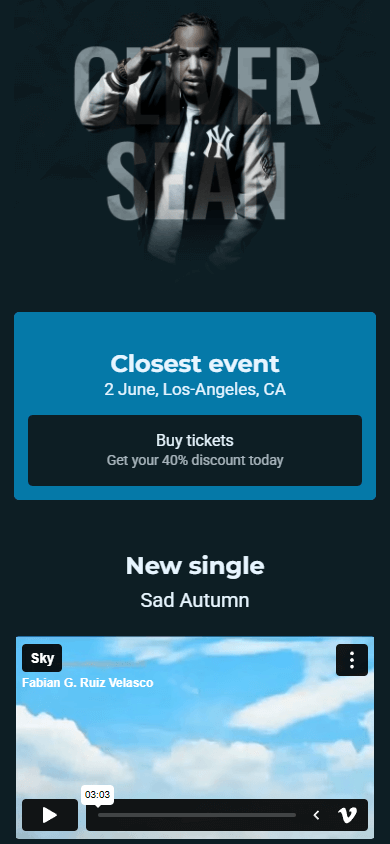
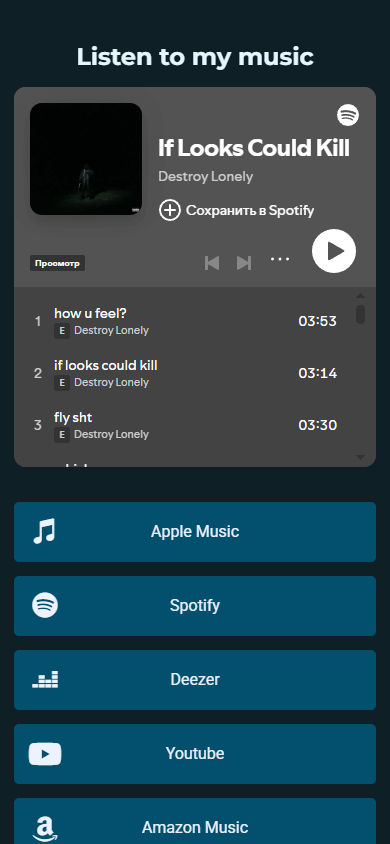

To view the live version of the page tap here.
This page was created using Taplink. Taplink is a great choice for musicians to create a link in bio page because it provides the following advantages:
- Fast creation: Set up your link in bio page in minutes. For example, the page above was built in just 15 minutes.
- No-code development: Taplink has a drag-and-drop interface meaning no technical skills are required to build a professional-looking page.
- Music and video support: You can embed your music videos or songs from different streaming platforms, and your followers can play them right from the page.
Building a link in bio page for musicians involves four steps:
- Sign up on Taplink.
- Choose a template that fits your branding. If you want a page like the one above, use this template.
- Customize your page.
- Publish your page.
Read more about how to create a link in bio page with all your music links.
Make sure to add your page link to every social media where you promote your music. Now your audience can access all the important information with one tap on the link in your bio.
When it comes to one of the most successful social media music marketing strategies, a clear and concise description in the bio or the About section is a sure way to go. It helps people quickly understand who you are and what you do.
That is why it’s important to focus on key details that make your profile stand out. Some details that you could add to your bio include:
- Your genre or style: Let people know what kind of music you create.
- New music or upcoming show: If you’ve just dropped a new single or album or have a concert coming up, be sure to let your followers know about it.
- A call to action: Encourage people to listen to your music, watch your videos, or buy a ticket to your show.
Here are some bio examples that align with effective social media marketing for musicians:
Get more ready-made bios for musicians in different genres, from rock artists to country singers and electronic performers.
Including your location in your social media profile is a strategy of social media marketing musicians should also pay attention to. It’s not all about live streams and international tours, the local scene matters too.
Social media algorithms prioritize accounts relevant to a user’s location. For example, fans searching for local live music are more likely to find your profile if your city is listed.
Make sure to add your location to the link in bio page we talked about earlier. With Taplink, you can not only type your address but also display it on a map. For instance, you can pinpoint your show’s exact location so your fans can instantly see where it will be held.
Below is what a map with your location could look like on your Taplink link in bio page.
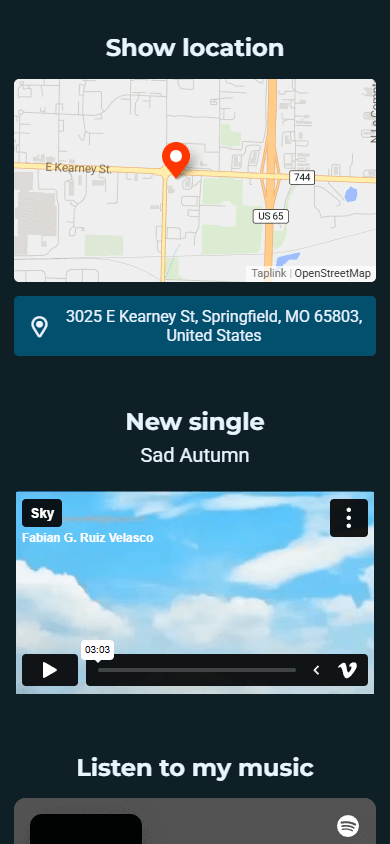
If you’re learning how to market your music on Instagram, TikTok, or other social media, integrating location details into your bio and Taplink page ensures you reach the right audience.
To further master social media music marketing strategies, it’s important to fill your music Instagram with different types of content to maintain audience interest. Your content could include announcements of new music or shows, educational content, a glimpse into your creative process, covers, memes, and user-generated content. Let’s dive into each of these categories one by one.
Announcing new singles and upcoming shows is crucial for informing fans and ensuring they don’t miss important events. Regular announcements directly impact concert attendance and music sales, helping musicians increase both their audience and revenue.
When announcing a new release or your show, use the following:
- Teasers and snippets: Share a short preview of your single or snippets of multiple songs on the album. Learn how to add music to your Instagram posts.
- Countdowns and reminders: Let your followers know how many days are left until you release a new single or album.
- Personal stories: Explain the meaning behind a song or the excitement of performing in a specific venue.
Prepare a brief content plan before making announcements so you don’t have to figure out how to remind your followers about the event each time. Let’s say, a month before the album drops, give your audience a hint that something exciting is coming. Two weeks before, share the album cover or a rehearsal clip. Then, one day before the release, post a final announcement and encourage your followers to turn on notifications so they don’t miss it.
When you master posting engaging announcements, you won’t ask yourself how to promote an album or a single on social media anymore. It’ll come naturally.
Sharing tutorials and educational content is a great way to connect with your audience while demonstrating your expertise and building credibility. Fans appreciate learning from musicians they admire, and informative posts can help you stand out, which is exactly how to successfully promote your music on social media.
Here are some creative ideas you can use for your social media:
- Track recording: Share with your followers how you record tracks, from choosing equipment to adding effects. Show them your home studio and explain the purpose of each tool.
- Freestyle techniques: If you’re good at freestyling, tell your followers how they can learn it too. Tell them what helped you develop this skill, what challenges you faced, and how you overcame them.
- Unusual instrument: If you own a rare or unusual instrument, show it to your followers. It might be a kalimba, harmonica, banjo, or any other uncommon instrument. Explain how it works, what sound it produces, how to play it, and, of course, play something for your audience.
If you prefer selling tutorials and guides instead of just posting them for free, add them to your Taplink link in bio page as digital products. On your page, followers can view their covers and read the descriptions. And you can sell your digital products right from your link in bio page.
See how a digital product looks on the musician’s Taplink link in bio page.
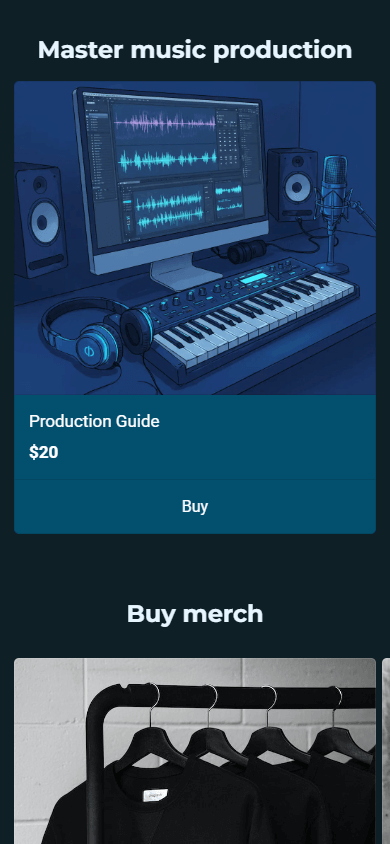
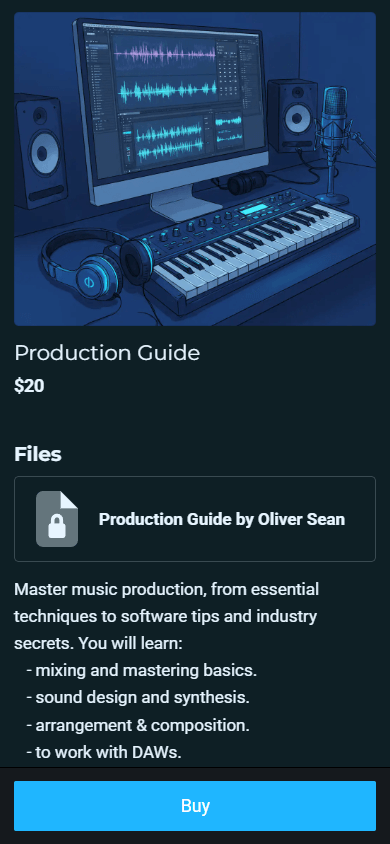
Recording and posting covers is a powerful way to attract people who know the original songs and are specifically looking for covers. If they enjoy your performance, they might follow you and begin listening.
It’s also an effective way of how to promote a song on YouTube since users of this platform are more accustomed to watching music videos and discovering new songs. However, you can also upload a cover onto Instagram or TikTok to reach a broader audience.
Don’t be afraid of changing something, listeners have the original songs if they want them, your goal is to show what you are made of. Adding a personal touch — such as changing the arrangement, experimenting with different genres, or incorporating original elements — sets your version apart.
To make the most of your covers and this technique of social media marketing for music artists, focus on song selection. Choosing trending hits increases visibility while covering classics can highlight your influences and musical roots.
Memes are frequently used as a social media marketing tool for music artists because they’re highly shareable and immediately capture people’s attention.
Posting this content also makes your profile simply more human. That’s valuable in a world where musicians start to gravitate to AI-generated content.
You don’t have to post music-related memes. It can be any meme you like. Those not involved in music will also see themselves in them and relate to you.
To make your meme posts more relevant, keep an eye on trends. The more popular the meme, the more attention it will draw to your post. So, if you’re not following trends in this area, consider doing so.
Even though people enjoy memes, keep a balance between humor and professionalism. Memes shouldn’t be the only content you post on social media. They should add to your content, not replace it.
One way how to promote music on Instagram, Facebook, and any other platform is by posting exclusive footage from behind the scenes. This content will help strengthen the bond with your audience and make your content more authentic.
Behind-the-scenes content can cover a wide range of moments from your life as a musician:
- Rehearsals: Show your followers how you practice your tracks, the vibe you try to achieve, the struggles you face, or the jokes you make with your team or bandmates.
- Your team: Introduce the team that helps you create your music, whether they are producers, sound engineers, or any other team members.
- Backstage: Post a video or photo of your green room. Show how you prepare for the performance, adjust your instruments, or warm up your voice.
There are many more behind-the-scenes content ideas. Capture everything you think is important outside of your performances. Just like the violinist below.
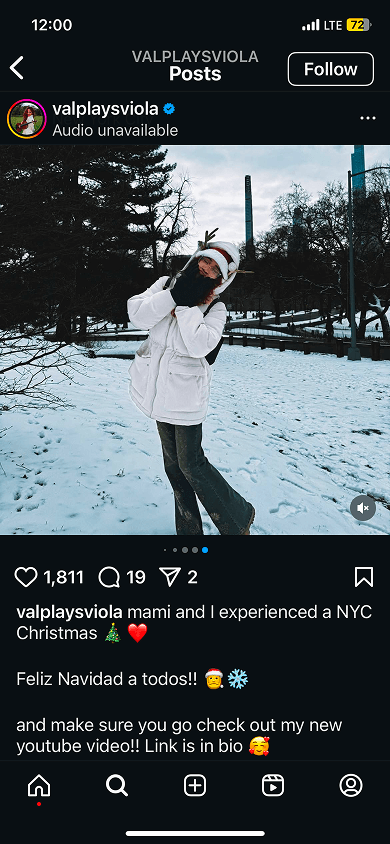
User-generated content (UGC) allows musicians to build stronger connections with their audience. Incorporating it into your social media music marketing strategies also helps reach new listeners through organic sharing.
User-generated content comes in many forms. It includes:
- Covers or remixes of your tracks.
- Photos and videos from your shows.
- Fan art.
- Reviews.
- Life moments set to your music.
To get some user-generated content as part of your social media marketing for musicians, encourage fans to create it. You could ask them, for example, to post videos or photos from your latest show or themselves playing covers of your songs.
When fans post this content, encourage them to tag your account in their posts. You can also create a unique hashtag to find your fans’ content and encourage them to use it.
Make sure to repost videos or photos made by your fans. Your audience will see that you appreciate their efforts, which will boost their loyalty to you.
Social media gives musicians a platform to share their work, but real engagement goes beyond just posting songs. Building a strong connection takes more than just great music — it requires creative ways to spark conversations and keep listeners engaged. Keep reading to find out how you can interact with your followers.
Running contests and challenges is an effective way to energize your audience. And participation encouragement is especially needed in social media marketing for music artists because just listening to music often leaves no room to interact with the artist.
We have suggested a few easy ideas that you can use in your social media marketing for musicians.
- Best fan art: As mentioned earlier, fan art is a great way to promote your music account on Instagram and other social media. Ask your followers to make a piece of art for you. It could be a portrait of you, your single or your album cover. Specify how your followers should create the fan art — whether they should use a digital editor, pencil, watercolor, or any other tool. As for the winner, let your followers pick it.
- Cover of your song: Ask your followers to cover one of your songs. Choose a song that’s not too hard so more people can try it. Explain whether participants can modify the arrangement, change the style, or if they need to reproduce the song as it is. Let the winner be the one who performs your track most accurately and with the highest quality.
- Video for your song: Offer your audience to create a music video for your song. Set rules for the video. For example, you could ask them to shoot a short story, a dance, a landscape, or just abstract shots. Then select the best video based on which one fits your song the most.
The prize for participating in your contests can be a lot of things. Options could include your merch, a free ticket to your show, or a musical instrument. Should you choose to run a contest for the best video, you could make the winning music video your official one.
Going live is one of the most effective ways to connect with fans in real time. It adds another personal touch to social media marketing for music artists, making interactions more dynamic. Regular live streams build anticipation and keep your audience engaged.
Your livestream can serve any purpose. You might want to announce a release, perform a short live set, host a Q&A session, or simply chat with your audience.
Make sure to get everything ready beforehand. Find a quiet place where no one will interrupt. Set up your background — it can be minimalistic or match the theme, like featuring your instruments. Adjust your equipment: camera, microphone, and tripod if you have one. Check the sound and lighting in advance.
Also, prepare a short session plan. For example, if your stream lasts 40 minutes, you can spend 5 minutes greeting viewers, 25 minutes focusing on the main topic, and 10 minutes answering questions.
Let your audience know about the stream ahead of time. Post about it 1–2 days before with all the details — date, time, and topic. Then, remind them again about an hour before you go live.
Below is an example of how the Opal in Sky rock band runs a live session with their subscribers on YouTube.

Thoughtful questions encourage discussions which should always be taken into consideration in social media marketing for musicians. Replies from your audience will also help you gain insight into their preferences and create content they genuinely enjoy.
If you want active engagement from your audience, avoid questions that can be answered with a simple “yes” or “no.” Instead, ask open-ended questions that encourage discussion. For example: “What was the most memorable moment of my performance today, and why?”
Engagement should go both ways — don’t just seek responses, but share your own stories too. Let’s say, you could film a short video about what inspired you to become a musician. In the end, ask your followers what inspired them to be what they are now.
Make sure to respond to your followers’ comments. This can be as simple as liking responses you enjoy or starting a discussion. It will show your audience that you value their input, encouraging them to interact with your posts more.
Email marketing is a powerful tool for musicians to maintain direct connections with fans beyond social media. Emails land directly in inboxes, ensuring your updates reach your audience.
People usually hesitate to share their email addresses unless they see a good reason to do so. To encourage them, offer a lead magnet.
A lead magnet is a freebie that subscribers get in exchange for their email. It could be a discount code, a tutorial on playing one of your songs, or any other valuable content.
To collect emails, create an opt-in form on your Taplink link in bio page. Taplink also allows you to automatically send a lead magnet to a subscriber as soon as they fill out your form.
Below is an example of what an opt-in form looks like on a link in bio page created with Taplink.
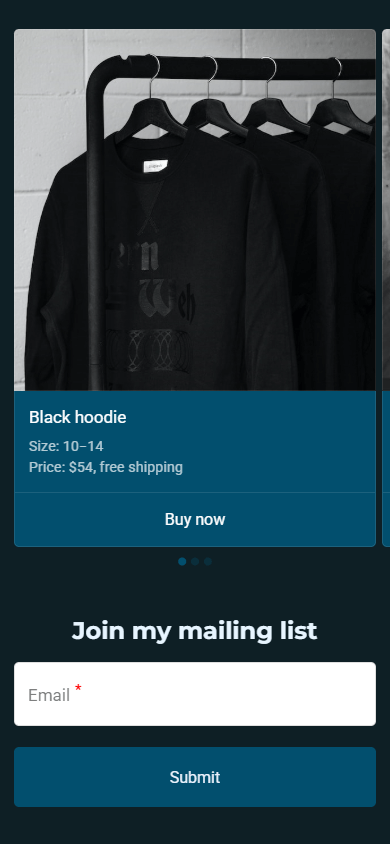
Mastering social media marketing for music artists isn’t just about being on socials — it’s about strategic engagement and involvement. To grow your following, focus on these key tactics:
- Know your audience: Tailor content based on age, genre, and financial habits to increase relevance.
- Optimize your profile description: Add a link to your musician's link in bio page, a text description, and your location to make it easier for fans to access your music, merch, and tour info.
- Create engaging content: Share announcements, tutorials, behind-the-scenes content, covers, memes, ad user-generated content.
- Interact with your audience: Go beyond just posting music. Spark conversations by running contests, asking thoughtful questions, going live to interact in real time, and running email marketing.
Effective social media marketing for musicians helps turn casual followers into active listeners who support you through music streams and concert attendance. Implement these social media music marketing strategies to amplify your reach and solidify your presence in the digital music landscape. And don't forget to use Taplink to make it easier for your social media followers to become your active listeners.